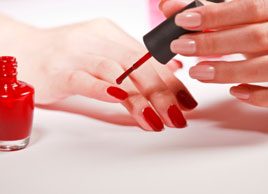The pros and cons of the long-lasting manicure
New polish techniques and products’such as Axxium and Shellac’are all the buzz. Writer Diane Peters tries out some of the latest nail trends

Source: Best Health Magazine, March/April 2012
It’s my first OPI Axxium Soak-Off Gel Lacquer, and it’s as if my technician tossed out the rules of a manicure with yesterday’s cotton balls. There’s no soaking my fingers in water‘it’s her opinion we can’t have my nails expand in water, then contract and crack the polish.
And there’s no sitting around afterwards waiting for it to dry: The five coats, including a base and topcoat, are cured in a hand-size UV lamp in just a couple of minutes per layer. The $50 manicure will last at least two weeks. It offers a layer of protection as if I’d been given artificial nails, yet unlike fake nails, this stuff is just painted on like a polish with no filing, bonding or sculpting. But the oddest thing about it is that everyone around me is talking about nothing but polish: the coolest colours and just how long their manicure lasted (for one woman, a month and still looking perfect’save a half-moon of natural nail that’s since grown at her cuticles).
Colourful, beautifully shaped nails have become a mainstream beauty obsession. No Canadian numbers are available, but according to U.S. market research, department store nail polish sales jumped 59 percent in the first 10 months of 2011, and the industry south of the border is worth more than $6 billion. For many, polish is an ‘affordable luxury,’ says Suzi Weiss-Fischmann, artistic director of Los Angeles’based OPI Products. Leeanne Colley of Tips Nail Bar & Spa in Toronto, where I had my nails done, surmises that ‘with the rise of smartphones, our hands are more visible. So having a coat of nail polish on is now a must.’
As nail companies try to cash in, we consumers benefit. ‘It’s a huge money-making industry, and there are so many brands out there,’ says Mary Phan, co-owner of Vicki’s Nail Studio in Vancouver. ‘The quality has improved a lot.’ For example, says Sunil Sirdesai, director and chief scientific advisor for OPI, manufacturers now use smaller, more versatile molecules, so the glitters have more shimmer and the new ‘crackle’ finishes look more professional.
Long-last pros and cons
Salon techniques like Axxium do more than offer a stand-in for polish. ‘Axxium helps with naturally chipping or peeling nails, or naturally dry nails with ridges,’ says Colley. Since it’s thick and gel-based like some synthetic nails, costs roughly the same and lasts just as long, some who want the synthetic-nail look now have another option. As well, Colley says she uses Axxium on toes in winter; its quick dry time is a benefit.
But there’s a downside: You have to return to the salon for an acetone soak and a gentle scrape-off that takes 20 minutes in addition to your manicure time. That’s fine for those who make salon visits part of their regular routine, but not for time-pressed, budget-conscious working moms like me.
Adding to the choices is Creative Nail Design’s Shellac. Victoria Hunter of Ongles Chez Victoria in Châteauguay, Que., specializes in nail art (a service where the technician enhances a straightforward polish with glitter, feathers or even freehand painting). But she now has a client base that comes in just for a Shellac manicure. It starts at $25, lasts as long as Axxium and, thanks to quicker UV curing times, goes on in just half an hour, compared to Axxium’s 45 minutes. It’s thinner, looks more like a polish and comes off in 10 minutes in the salon (it also has a home-kit removal option).
The success of these two products, which last at least a couple of weeks (at which point your new nail growth will be pretty obvious at the cuticle), has inspired imitators such as Gelish and Gelac. And in the fall of 2011, OPI debuted GelColor, with easier removal, and a faster cure using LED UV.




